A sudden power flicker during a critical procedure can cause the main display to go dark. This momentary loss of imaging can create unacceptable risks for patient safety.
Dual AC input and external UPS both ensure uninterrupted power for medical-grade monitors. Dual input offers simplicity and low maintenance, while UPS adds surge protection and multi-device coverage. Choice depends on infrastructure and risk profile.
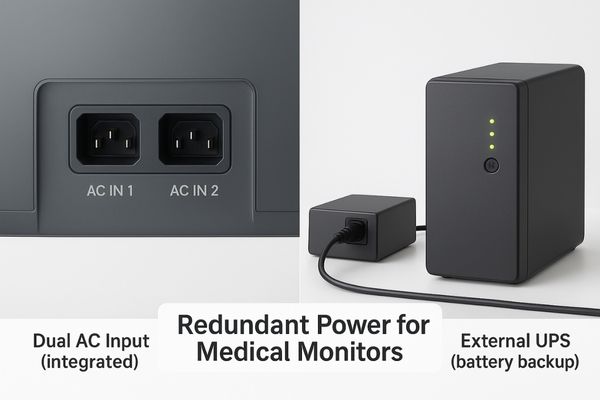
In any high-dependency clinical setting, from the operating room to the intensive care unit, the continuous availability of visual information is non-negotiable. A momentary power interruption is not just an inconvenience; it represents a critical failure that can compromise a procedure or diagnosis. To mitigate this risk, medical-grade monitors1 often incorporate redundant power systems. The two dominant designs are built-in dual AC inputs, which automatically switch between two independent power circuits, and external Uninterruptible Power Supply (UPS) systems2, which provide battery backup during an outage. While both aim for the same outcome—uninterrupted operation—they achieve it through different means. Understanding the distinct principles, benefits, and trade-offs of each approach is essential for making an informed procurement decision that aligns with an institution’s specific infrastructure, risk tolerance, and operational needs.
Overview of Redundant Power Designs in Medical-Grade Monitors
Power instability in a hospital can interrupt imaging, posing a direct threat to patient safety. This risk makes a standard single-input power design insufficient for critical care environments.
Two primary redundant power designs exist: built-in dual AC inputs with automatic switching and external UPS systems providing battery backup. Each offers distinct advantages in reliability, complexity, and cost.
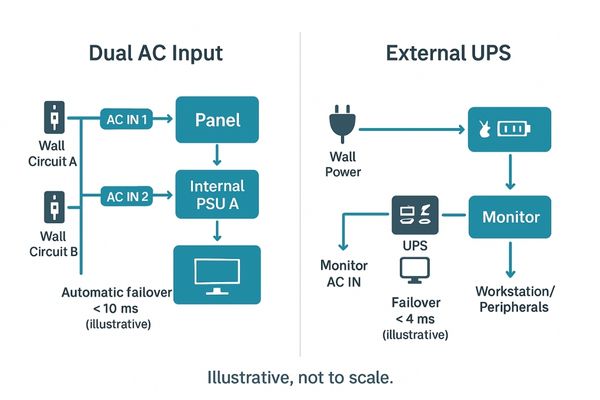
In critical medical environments, maintaining a constant visual feed is paramount. A power interruption, even for a fraction of a second, can have profound consequences. To address this, manufacturers have developed redundant power solutions to ensure that monitors remain operational through power sags, flickers, or complete outages on a primary circuit. The first mainstream approach is the integrated dual AC input system3. This design physically builds two separate power inputs and modules into the monitor itself, allowing it to connect to two independent electrical circuits simultaneously. The second common approach relies on an external Uninterruptible Power Supply (UPS)4. A UPS is a separate device that sits between the wall outlet and the medical monitor, using an internal battery to supply power instantly if the main utility power fails. The choice between an integrated or external solution involves a careful evaluation of trade-offs. This includes failover speed, maintenance requirements, infrastructure complexity, total cost of ownership, and compliance with medical safety standards.
Dual AC Input Architecture: Principle and Failover Mechanism
Relying on a single power circuit creates a single point of failure. If that circuit is compromised, the display goes dark, regardless of its internal quality.
Dual AC input designs connect a monitor to two independent power circuits. An onboard controller switches to the secondary source in under 10 ms if the primary fails, preventing any visible interruption.
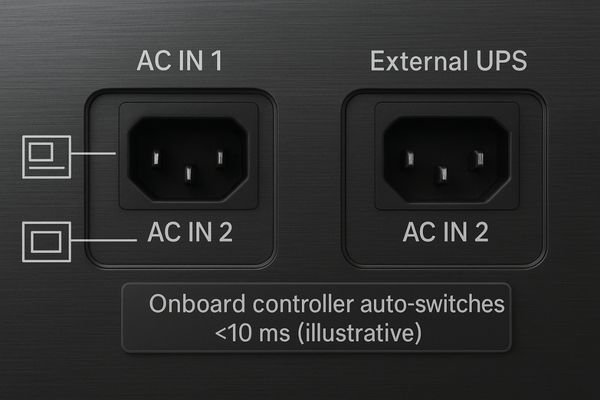
The dual AC input architecture5 is an elegant, integrated solution for power redundancy. The core principle involves designing the monitor with two independent internal power modules, each connected to its own AC inlet. These two inlets are then connected to separate, independent power circuits within the hospital’s electrical infrastructure—ideally one backed by a generator and one on standard utility power. A sophisticated power management controller6, often managed by the monitor’s DSP, constantly monitors the voltage from the primary input. If it detects a voltage drop, sag, or complete failure, it instantly switches the monitor’s internal power draw to the secondary AC input. This failover process is incredibly fast, typically executed in under 10 milliseconds. This speed is well below the threshold of human perception (~16 ms), meaning the screen never appears to flicker or turn off. This built-in redundancy simplifies the installation by eliminating the need for an external UPS, which in turn reduces cable clutter and frees up valuable space on equipment carts or OR booms.
External UPS Systems: Working Mode and Power Continuity
A power outage affecting an entire room or floor can disable all equipment. Without a local battery backup, even dual-circuit systems can fail if both circuits are lost.
An external UPS provides continuous power from an internal battery, switching instantly during an outage. It also offers surge protection and can support multiple devices, but requires periodic battery replacement.

An Uninterruptible Power Supply (UPS)7 provides a different, externalized layer of power protection8. In its normal operating mode, the UPS passes utility power through to the connected devices while also charging its internal batteries. The key function of a UPS is its ability to detect a power failure and switch to battery power almost instantaneously. The failover time for a modern line-interactive or online UPS is typically less than 4 milliseconds, providing a seamless transition that is completely transparent to the connected equipment. In addition to providing backup during a complete outage, a UPS also conditions the power, offering valuable protection against power surges, sags, and electrical noise. This can extend the life of sensitive medical electronics. A single, larger UPS unit can provide backup for an entire workstation, including the monitor, CPU, and other peripherals. However, this approach introduces its own complexities, most notably the need for regular battery maintenance and replacement, which typically occurs every three to five years. The physical footprint of the UPS also needs to be considered in space-constrained environments.
Electrical Safety and IEC 60601 Compliance
Connecting any electrical device in a patient-care vicinity poses safety risks. Both power redundancy solutions must be verified to prevent electrical shock or electromagnetic interference.
Both dual input monitors and external UPS systems must comply with IEC 60601-1 for electrical safety. Integrated designs often include internal protective earth and leakage current monitoring, simplifying overall compliance.
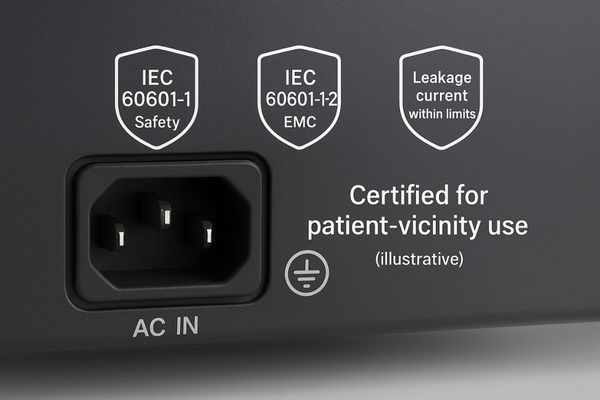
Regardless of the redundancy method chosen, any component used in a medical environment must adhere to the stringent IEC 60601 family of standards9. IEC 60601-1 is the primary standard for medical electrical equipment, governing basic safety aspects like protection against electric shock, mechanical hazards, and excessive temperatures. This applies to both the monitor itself and any external UPS unit intended for medical use. A key consideration is leakage current—the tiny amount of current that can flow from the device to the patient or operator. Both systems must be designed to keep this current well below specified limits. A monitor with an integrated dual input system often has an advantage here, as all safety monitoring for protective earth continuity and leakage current10 is engineered into a single, certified device. When using an external UPS, both the UPS and the connected monitor must be individually compliant, and the combined leakage current of the entire system must be considered, which can sometimes complicate the certification and safety verification process for the end user.
Failover Time and System Reliability Comparison
In a critical event, the speed of power failover determines if an interruption is noticed. Both systems must be fast enough to prevent a screen flicker.
An external UPS typically fails over in under 4 ms, while a dual input system switches in under 10 ms. Both are imperceptible and highly reliable, with the choice depending on the desired failure mode protection.
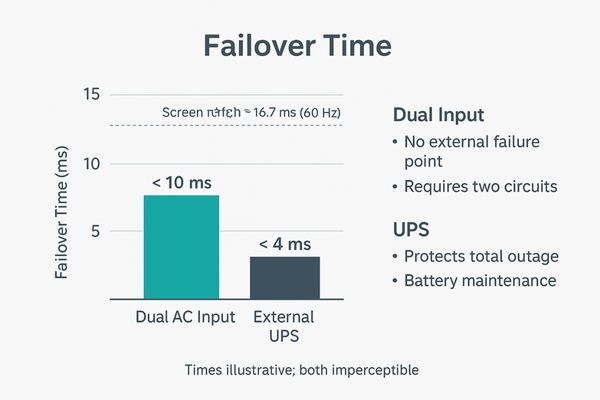
When comparing the core performance of the two systems, failover time is a key metric. A typical screen refresh takes about 16.7 milliseconds (at 60Hz), so any failover event faster than this will be invisible. External UPS systems, particularly online models, have a near-instantaneous switchover time, often cited as 0 ms or less than 4 ms for line-interactive models. Integrated dual AC input systems11 are slightly slower, with a failover time12 typically specified as under 10 milliseconds. While the UPS is technically faster, both are well within the imperceptible range, making the practical difference negligible. The more significant comparison lies in system reliability and failure points. A dual input monitor is protected against the failure of one entire electrical circuit. It eliminates the single point of failure that the UPS unit itself can represent (e.g., battery or inverter failure). Conversely, a UPS can protect against a total facility power loss that takes out both circuits, providing a short-term bridge until backup generators engage.
| Feature | Dual AC Input | External UPS System |
|---|---|---|
| Failover Time | < 10 ms (Imperceptible) | < 4 ms (Imperceptible) |
| Key Advantage | High integration, no external failure points | Protects against total power loss, surge protection |
| Primary Failure | Unprotected if both facility circuits fail | The UPS unit itself is a single point of failure |
| Complexity | Low; integrated into the monitor | Higher; requires external device and cabling |
Maintenance, Cost, and Infrastructure Requirements
Initial purchase price is only part of the total investment. Ongoing maintenance, servicing, and infrastructure needs can significantly impact the total cost of ownership over the product’s lifecycle.
Dual input systems are virtually maintenance-free with a one-time cost. UPS systems require ongoing battery servicing and replacement, adding to both upfront and long-term expenses, and require dedicated physical space.

The financial and logistical implications of each approach differ significantly. The dual AC input feature13 is a one-time capital expense built into the cost of the monitor. Once installed, it requires no specific maintenance beyond standard IT practices. This design does, however, presuppose that the healthcare facility has the necessary electrical infrastructure—namely, two independent circuits available where the monitor will be used. In contrast, an external UPS system14 involves both an upfront cost for the unit and significant ongoing operational expenses. The internal batteries have a finite lifespan of 3-5 years and require periodic testing and eventual replacement, which involves both material and labor costs. UPS units also generate heat and often require placement in a climate-controlled area, adding to infrastructure demands. Furthermore, they occupy physical space, which can be a critical issue on crowded OR booms or equipment carts. While a UPS offers broader protection, this comes at a demonstrably higher total cost of ownership.
Suitability for Operating Rooms and Radiology Suites
The ideal power redundancy solution depends on the clinical environment. The demands of a fast-paced OR are different from those of a centralized diagnostic reading room.
The simplicity and reliability of dual input architecture are ideal for space-constrained operating rooms. In radiology suites, a centralized UPS can efficiently provide resilience for multiple diagnostic workstations.
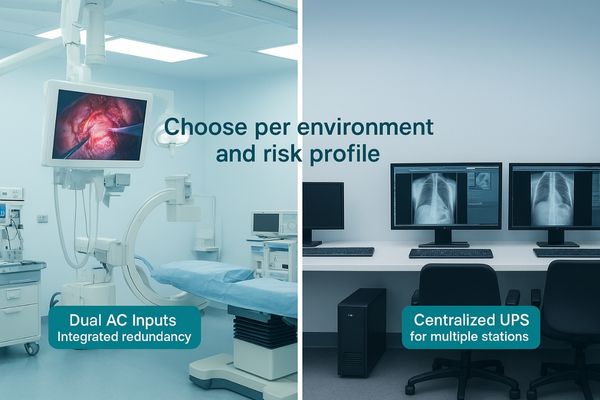
The choice between dual AC input15 and an external UPS16 is highly context-dependent. In the operating room, where space is at a premium and reliability is paramount, the integrated dual AC input design is often the superior choice. It minimizes clutter on surgical booms, reduces the number of potential failure points, and simplifies installation and maintenance. The self-contained nature of a monitor like the MS550P with dual inputs is perfectly suited to the dynamic and demanding OR environment. In a diagnostic radiology suite, the calculus may be different. Reading rooms often contain multiple high-performance workstations in a centralized location. In this scenario, it can be more efficient and cost-effective to protect several stations at once using a larger, centralized UPS system. This system can be managed by the IT department as part of the facility’s core infrastructure, providing comprehensive protection for a group of diagnostic displays and their associated computers. Here, the extra space and maintenance requirements of the UPS are more easily absorbed.
Reshin’s Design Approach to Redundant Power Systems
A monitor manufacturer must make a deliberate choice in its redundancy strategy. This choice reflects the brand’s philosophy on reliability, integration, and user convenience.
My design philosophy prioritizes integrated, maintenance-free solutions. Our surgical and diagnostic monitors feature dual isolated AC inputs with independent power modules, meeting IEC safety standards and providing sub-10 ms failover.
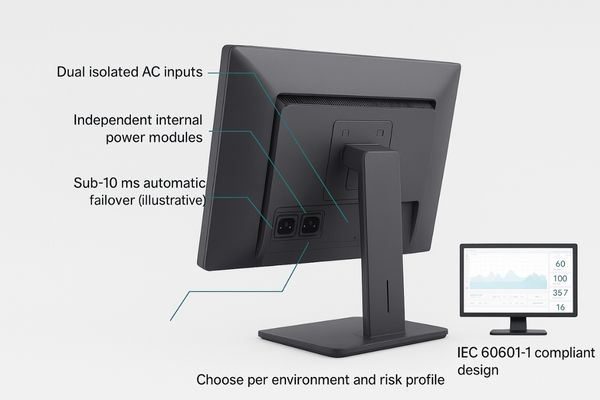
My approach to designing power systems is guided by a commitment to creating integrated, robust, and user-friendly solutions that minimize complexity for the end user. I believe that essential safety and reliability features should be built directly into the device whenever possible. For this reason, my medical-grade monitors17 for both surgical and diagnostic applications are engineered with dual isolated AC inputs. This architecture features two completely independent internal power modules, providing true redundancy without reliance on external hardware. This design choice eliminates the ongoing maintenance burden and hidden costs associated with external UPS batteries. Our systems are designed to exceed the requirements of IEC 60601-118, with all safety mechanisms contained within a single certified unit. With a failover time of under 10 milliseconds, the switch is imperceptible, ensuring absolute continuity of the clinical image. By integrating this capability directly into our monitors, we provide hospitals with a solution that is simpler to install, safer to operate, and more reliable over its entire lifespan.
Conclusion
The choice between dual AC input and an external UPS depends on clinical needs and infrastructure, but both effectively prevent imaging loss and protect patient safety in critical environments.
📩 Need help selecting the right power backup solution for your medical displays? Contact Martin at martin@reshinmonitors.com for expert recommendations from Reshin.
-
Explore this link to understand how medical-grade monitors enhance patient safety and operational efficiency in critical care environments. ↩
-
Learn about UPS systems and their crucial role in maintaining power during outages, ensuring continuous care in medical facilities. ↩
-
Exploring this system can provide insights into advanced power solutions for medical equipment reliability. ↩
-
Understanding UPS technology is crucial for ensuring continuous power in critical medical environments. ↩
-
Explore this link to understand how dual AC input architecture enhances power redundancy and reliability in critical systems. ↩
-
Learn about power management controllers to see how they ensure efficient power usage and reliability in devices. ↩
-
Understanding UPS technology is crucial for ensuring reliable power protection for sensitive devices. ↩
-
Exploring power protection methods can help you safeguard your electronics from damage and extend their lifespan. ↩
-
Understanding the IEC 60601 standards is crucial for ensuring safety and compliance in medical devices, making this resource invaluable. ↩
-
Exploring leakage current helps in grasping its impact on patient safety and device compliance, essential for anyone in the medical field. ↩
-
Exploring dual AC input systems can reveal how they enhance reliability and eliminate single points of failure in electrical circuits. ↩
-
Understanding failover time is crucial for evaluating system reliability and performance in power management. ↩
-
Explore this link to understand how dual AC input can enhance efficiency and reduce long-term costs in healthcare settings. ↩
-
This resource will provide insights into the cost implications and operational challenges of external UPS systems in various environments. ↩
-
Explore this link to understand how dual AC input enhances reliability and efficiency in medical settings. ↩
-
Learn about the benefits of using an external UPS for protecting multiple workstations in diagnostic radiology. ↩
-
Explore this link to understand how medical-grade monitors enhance safety and reliability in healthcare settings. ↩
-
Learn about IEC 60601-1 to see how it sets safety standards for medical devices, ensuring patient safety and device reliability. ↩


